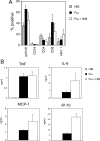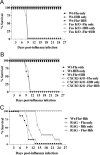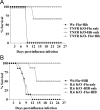A mouse model of lethal synergism between influenza virus and Haemophilus influenzae
- PMID: 20042666
- PMCID: PMC2808086
- DOI: 10.2353/ajpath.2010.090596
A mouse model of lethal synergism between influenza virus and Haemophilus influenzae
Abstract
Secondary bacterial infections that follow infection with influenza virus result in considerable morbidity and mortality in young children, the elderly, and immunocompromised individuals and may also significantly increase mortality in normal healthy adults during influenza pandemics. We herein describe a mouse model for investigating the interaction between influenza virus and the bacterium Haemophilus influenzae. Sequential infection with sublethal doses of influenza and H. influenzae resulted in synergy between the two pathogens and caused mortality in immunocompetent adult wild-type mice. Lethality was dependent on the interval between administration of the bacteria and virus, and bacterial growth was prolonged in the lungs of dual-infected mice, although influenza virus titers were unaffected. Dual infection induced severe damage to the airway epithelium and confluent pneumonia, similar to that observed in victims of the 1918 global influenza pandemic. Increased bronchial epithelial cell death was observed as early as 1 day after bacterial inoculation in the dual-infected mice. Studies using knockout mice indicated that lethality occurs via a mechanism that is not dependent on Fas, CCR2, CXCR3, interleukin-6, tumor necrosis factor, or Toll-like receptor-4 and does not require T or B cells. This model suggests that infection with virulent strains of influenza may predispose even immunocompetent individuals to severe illness on secondary infection with H. influenzae by a mechanism that involves innate immunity, but does not require tumor necrosis factor, interleukin-6, or signaling via Toll-like receptor-4.
Figures









Comment in
-
New look at an old problem: bacterial superinfection after influenza.Am J Pathol. 2010 Feb;176(2):536-9. doi: 10.2353/ajpath.2010.090880. Epub 2009 Dec 17. Am J Pathol. 2010. PMID: 20019194 Free PMC article.
Similar articles
-
Haemophilus influenzae LicB contributes to lung damage in an aged mice co-infection model.Microb Pathog. 2016 Jan;90:1-6. doi: 10.1016/j.micpath.2015.10.010. Epub 2015 Oct 28. Microb Pathog. 2016. PMID: 26521136
-
PHiD-CV induces anti-Protein D antibodies but does not augment pulmonary clearance of nontypeable Haemophilus influenzae in mice.Vaccine. 2015 Sep 11;33(38):4954-61. doi: 10.1016/j.vaccine.2015.07.034. Epub 2015 Jul 26. Vaccine. 2015. PMID: 26212006
-
Correlation of adhesion molecules and non-typeable haemophilus influenzae growth in a mice coinfected model of acute inflammation.Microbes Infect. 2021 Sep-Oct;23(8):104839. doi: 10.1016/j.micinf.2021.104839. Epub 2021 May 21. Microbes Infect. 2021. PMID: 34023525
-
Pathogenic mechanisms of invasive group A Streptococcus infections by influenza virus-group A Streptococcus superinfection.Microbiol Immunol. 2018 Mar;62(3):141-149. doi: 10.1111/1348-0421.12577. Microbiol Immunol. 2018. PMID: 29377225 Review.
-
Postinfluenza bacterial pneumonia: host defenses gone awry.J Interferon Cytokine Res. 2010 Sep;30(9):643-52. doi: 10.1089/jir.2010.0049. J Interferon Cytokine Res. 2010. PMID: 20726789 Free PMC article. Review.
Cited by
-
Rotavirus Degrades Multiple Interferon (IFN) Type Receptors To Inhibit IFN Signaling and Protects against Mortality from Endotoxin in Suckling Mice.J Virol. 2017 Dec 14;92(1):e01394-17. doi: 10.1128/JVI.01394-17. Print 2018 Jan 1. J Virol. 2017. PMID: 29070687 Free PMC article.
-
Viral and bacterial interactions in the upper respiratory tract.PLoS Pathog. 2013 Jan;9(1):e1003057. doi: 10.1371/journal.ppat.1003057. Epub 2013 Jan 10. PLoS Pathog. 2013. PMID: 23326226 Free PMC article. Review.
-
Severe Pneumonia Caused by Coinfection With Influenza Virus Followed by Methicillin-Resistant Staphylococcus aureus Induces Higher Mortality in Mice.Front Immunol. 2019 Jan 30;9:3189. doi: 10.3389/fimmu.2018.03189. eCollection 2018. Front Immunol. 2019. PMID: 30761162 Free PMC article.
-
Coinfection with influenza virus and non-typeable Haemophilus influenzae aggregates inflammatory lung injury and alters gut microbiota in COPD mice.Front Microbiol. 2023 Mar 30;14:1137369. doi: 10.3389/fmicb.2023.1137369. eCollection 2023. Front Microbiol. 2023. PMID: 37065141 Free PMC article.
-
The role of the microbiota in respiratory virus-bacterial pathobiont relationships in the upper respiratory tract.medRxiv [Preprint]. 2024 Oct 23:2024.10.22.24315478. doi: 10.1101/2024.10.22.24315478. medRxiv. 2024. Update in: Nat Commun. 2025 Jun 4;16(1):5195. doi: 10.1038/s41467-025-60552-4. PMID: 39502658 Free PMC article. Updated. Preprint.
References
-
- Simonsen L. The global impact of influenza on morbidity and mortality. Vaccine. 1999;17(Suppl 1):S3–S10. - PubMed
-
- Thompson WW, Shay DK, Weintraub E, Brammer L, Bridges CB. Cox NJ, Fukuda K: Influenza-associated hospitalizations in the United States. JAMA. 2004;292:1333–1340. - PubMed
-
- Wong CM, Chan KP, Hedley AJ, Peiris JS. Influenza-associated mortality in Hong Kong. Clin Infect Dis. 2004;39:1611–1617. - PubMed
-
- Yap FH, Ho PL, Lam KF, Chan PK, Cheng YH, Peiris JS. Excess hospital admissions for pneumonia, chronic obstructive pulmonary disease, and heart failure during influenza seasons in Hong Kong. J Med Virol. 2004;73:617–623. - PubMed
-
- Sethi S. Bacterial pneumonia. Managing a deadly complication of influenza in older adults with comorbid disease. Geriatrics. 2002;57:56–61. - PubMed
Publication types
MeSH terms
Grants and funding
LinkOut - more resources
Full Text Sources
Other Literature Sources
Medical
Molecular Biology Databases
Research Materials
Miscellaneous

